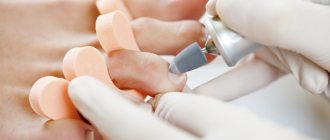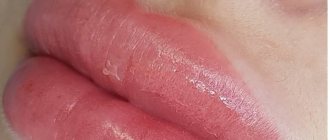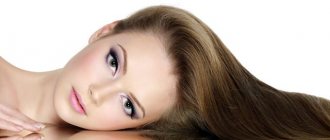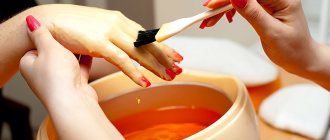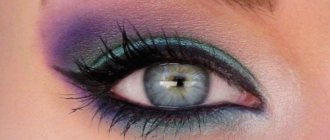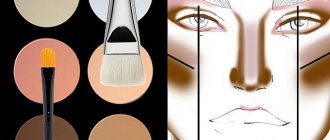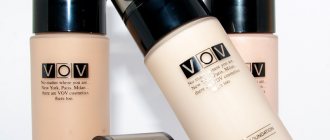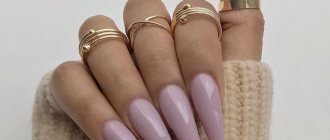Every woman wants to be happy and feel perfect in any situation. To do this, you need to take care of your health and care for your body every day. We must not forget about the feet: systematically performing a pedicure helps relieve fatigue and create an easy gait. Moreover, the procedure is available both at home and in specialized offices.
Pedicure is a set of practical measures for caring for nails and skin of the feet, including:
- removal of calluses, corns, keratinized skin;
- cleaning the nail plate;
- treatment of cracked heels;
- filing nails, giving them a beautiful shape;
- cuticle removal;
- correction of ingrown nails;
- lengthening of the nail bed;
- applying coating to nails;
- treatment of the soles of the feet using peeling, masks, baths;
- application of moisturizers and emollients;
- acupressure foot massage.
This type of care not only gives toenails a neat, aesthetic appearance, but also prevents the development of skin diseases and foot deformities. It needs to be done less often than a manicure - once every 2-3 months is enough.
Structure of toenails
The nail is located at the tip of the outer side of the finger, representing a shiny elastic plate of keratinized epidermis. It prevents damage to the finger from mechanical impact, thereby performing a protective function. The nail is a non-living tissue; it does not have nerve endings or blood vessels, which allows it to be removed painlessly.
The structure of the nail looks like this:
- The matrix is the basis for the formation of the plate, its “soil”. How thick and wide the nail will be, and how quickly it will grow, depends on the matrix.
- The nail bed is a layer of connective tissue covered with blood vessels on which the nail is formed. Due to the nerve endings, damage to the bed is very painful.
- The nail plate is the visible outer part of the nail.
- The cuticle is a skin roll that fits tightly to the base of the plate, protecting the matrix from dirt, dust, and harmful bacteria.
Toenails grow on average 3 times slower than fingernails. The nail plate is completely replaced with a new one in 4.5 months.
What length is considered optimal?
There is no correct answer to this question. And period. It all depends on the length and shape of your nail plate. If it is elongated, then it is better to cut it as short as possible. If there is free space left to the edge of the finger, then it is permissible to grow 1-1.5 mm in length. But you shouldn’t overdo it - long claws on your feet look as unaesthetic as possible.
Read also: Why do we need thermal protection for hair (and is it really necessary?)
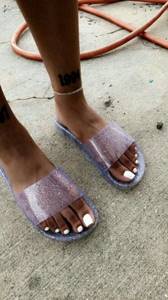
How to cut your toenails correctly
The toenails are quite thick, the skin on the plate is “pulled” tightly, so in order to trim them without negative consequences, you need to follow the algorithm:
- Prepare supplies in advance: nail scissors or clippers, nail file, towel, soap, bath with warm water. All instruments must be clean and disinfected.
- Place your feet in a container with water and dissolved soap and let them steam for 5-10 minutes (depending on the condition of the skin).
- Dry your feet with a towel.
- Trim the plates in an even line from edge to edge, without rounding the sides, otherwise the likelihood of ingrown nails increases. You cannot cut at the root; you need to leave an edge of about 1 mm.
- Trim the edges of the plate with a file and, if desired, treat your feet with moisturizer.
Execution technology

Depending on the specific problem, the medical pedicurist performs a number of actions to help treat the disease or alleviate the client’s condition.
If the pathology cannot yet be completely cured, he will take measures to achieve long-term and sustainable remission.
General procedure for medical pedicure:
- Oral conversation with the client. Definition of the problem, identification of possible factors of its occurrence;
- Visual examination of the affected foot;
- Prescribing a treatment regimen and necessary manipulations;
- Carrying out a pedicure procedure using the instruments and products selected for treatment - keratolytics, blades, staples;
- Skin hydration and cuticle hydration.
Decorative coating of nails in medical pedicure, as a rule, is not carried out. Informing the client about the purpose and method of the treatment procedure is mandatory. This will allow him to calm down, relax, and not strain the muscles of his feet.
Ingrown nail
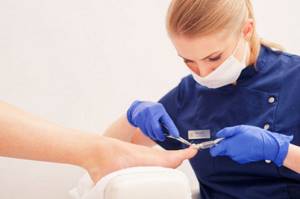
Before the advent and spread of medical pedicure, the problem of ingrown toenails was solved only in the surgeon's office. Now you can correct the situation without surgery.
Causes of ingrown nails:
- Improper cutting of nails during pedicure, poor quality treatment of the free edge of the nail on the big toe;
- Systematic heavy load on the feet, including due to excess weight;
- Wearing shoes that don't fit;
- Flat feet;
- Hallux valgus;
- Diseases associated with disruption of the functioning of internal organs, for example, diabetes;
- Skin diseases affecting the nail structure - fungus, psoriasis;
- Anatomical features.
Symptoms:
- Constant pain in the ingrowth area;
- Inflammation and purulent discharge;
- Deformation of the finger shape, pathological proliferation of soft tissues.
For treatment, a podiatrist:
- Performs a visual inspection of the foot, analyzes the degree of ingrowth and conducts a survey to determine the systematic nature of the problem. If the ingrown nail has already reached an advanced stage, the master sends the client to a surgeon for subsequent removal of the nail plate;
- Makes a cast of a nail from acrylic or plaster, completely repeating all its features;
- Makes a bracket. This requires 3-5 days;
- Places prepared wire material on the problematic nail.
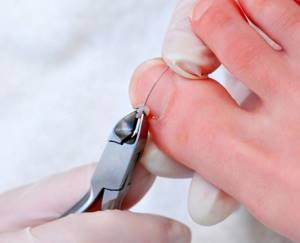
Lyudmila Sheveleva
Doctor, pharmacist
Ask a Question
Please note that sometimes a visual examination alone is not enough to make a diagnosis. An x-ray is also performed in two projections to identify signs of the spread of purulent inflammation. The study is indicated in severe cases, therefore it is prescribed to few patients. Treatment of an ingrown toenail is not limited to one visit to a specialist. Depending on the individual characteristics of the patient, the problem is solved from 1 month to 2 years.
After installing the brace, the patient must:
- Come for correction at least once every 2 months;
- Keep your feet clean by washing them several times a day with soapy water;
- Wear comfortable shoes that do not squeeze the problem toe.
In addition to staples, threads and plates are also used. The technology for working with them is practically the same and excludes only the creation of an impression.
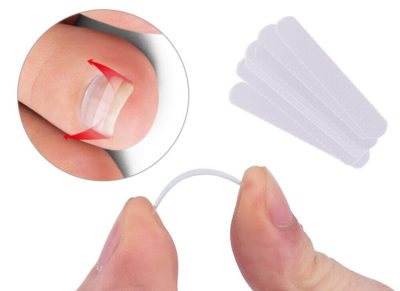
Core calluses
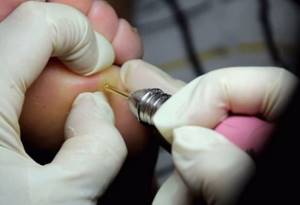
If you develop a compacted, painful callus, do not self-medicate - if it is a core, deep callus, you will not be able to deal with it with creams.
Causes of calluses:
- Constantly wrinkled shoe insoles, causing foot friction;
- Damage to the skin, for example, a splinter;
- Poor quality shoes that do not allow air to pass through;
- Too high heels or, conversely, flat soles;
- Fungus or viral infection;
- Entry of small foreign bodies into the skin of the foot;
- Frequent walking barefoot;
- Clubfoot, flat feet;
- Presence of dry calluses;
- Excess body weight.
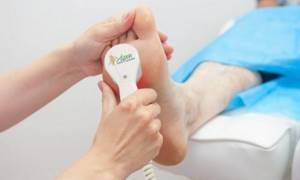
Several methods of removing callus are used:
- Cryodestruction . The most common method, tested repeatedly in the fight against calluses of varying severity. It involves burning with liquid nitrogen. Under the influence of ultra-low temperature, keratinized cells become necrotic. The procedure lasts less than one minute and has a low recurrence rate.
- Laser destruction . The laser removes the callus down to the very base. The main advantage of the method is that during the procedure all bacteria formed in the deep layers of the epidermis are removed. After laser removal, no inflammatory processes occur;
- Hardware removal . The technician drills out the callus using a special nozzle, carefully cleaning the resulting canal. After the procedure, a product with an antibacterial effect is placed into the vacated cavity. There are no complications after such removal. The risk of inflammation and relapse is almost zero. Complete reduction of the callus is carried out within 1-5 sessions.
Prevention:
- Choose shoes made of genuine leather or suede so that your feet always “breathe”;
- Change shoe insoles immediately after they become deformed - scuffs, bruises and tears;
- Do a pedicure systematically - treat the skin with pumice, scrubs or keratolytics;
- Don't wear other people's shoes.
Gehwol products for solving foot skin problems
Hyperkeratosis
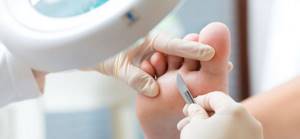
Hyperkeratosis is a foot disease accompanied by an increase in the number of keratin cells and thickening of the stratum corneum. If you notice symptoms of hyperkeratosis, contact a specialist who will prescribe medication or hardware treatment.
Symptoms of hyperkeratosis:
- The appearance of coarsened, compacted areas;
- Peeling and dryness;
- Change in skin color in rough areas. Instead of pinkish, corns take on a white or yellowish tint;
- Pain and burning when walking;
- Feeling of stiff feet.
After contacting the podiatrist, the specialist:
- Conducts an examination to confirm the diagnosis and determine its neglect;
- Uses emollients - keratolytics, which destroy lipid bonds and facilitate the removal of the stratum corneum;
- Cuts off keratinization with a scalpel without damaging soft tissue;
- Grinds the skin with a milling cutter with a ceramic attachment.
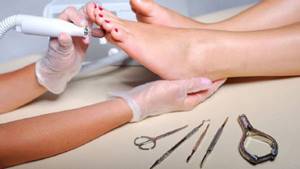
In addition to hardware removal of hyperkeratosis foci, more modern techniques are used as part of medical pedicure:
- Laser burning. The laser dries out the keratinization, leaving a small scar on the skin;
- Freezing of keratinized tissues with liquid nitrogen;
- Excision of corns with an electric knife;
Prevention of hyperkeratosis:
- Choose comfortable shoes made from quality materials;
- Use moisturizing creams;
- Carry out periodic removal of the stratum corneum with pumice, scrubs or keratolytics;
- Start treating skin diseases in a timely manner.
Please note that without prevention, hyperkeratosis will definitely return. It should be remembered that with age, the roughening of the skin on the feet becomes more and more pronounced.
Foot skin problems and what a pedicurist should do if they exist
Cracks
Skin cracks on the feet and heels are a violation of the integrity of the skin associated with deep tears. Minor cracks can be eliminated using moisturizing creams and healing ointments, but for more serious cracks, a systematic medical pedicure procedure will be required.
It is important to know that cracks are not an independent disease, but only a manifestation of a more serious pathogenic process developing in the body.
Common causes of ruptures are:
- Disorders of the thyroid gland;
- Diabetes;
- Psoriasis;
- Avitaminosis;
- Disturbed hormonal levels;
- Incorrectly selected shoes;
- Too active lifestyle.
The pedicure procedure consists of:
- Conversations between a specialist and a client, identifying possible causes of crack formation;
- Examination of the affected foot and analysis of the degree of neglect;
- Filing the skin around cracks to improve penetration of healing agents;
- Prescriptions of medicinal ointments and creams.
Cracks in the skin of the heels - treatment and prevention
Creams and preparations for cracked heels
Medical pedicure for the treatment of cracks will have to be repeated every two weeks. This will allow the podiatrist to promptly and professionally get rid of growths and monitor the overall change in condition.
Lyudmila Sheveleva
Doctor, pharmacist
Ask a Question
In addition, the podologist can send you to a dermatologist, who will prescribe the necessary tests to identify the real cause of the formation of cracks. But no matter what, you need to start treatment immediately. Moreover, the cracks cause pain while walking.
How to choose foot cream with urea
Nail deformation
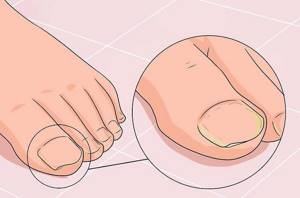
Nail deformation is a change in the structure and appearance of the nail plate, which causes not only external discomfort, but also pain.
In this case, it is impossible to solve the problem with creams and medicinal varnishes - you must contact a specialist.
Deformation of the nail plate is determined by visual examination and is confirmed if the nails:
- They have grooves, depressions, bulges;
- Cracks at the base;
- They have a blue tint;
- Globular, very convex;
- Curved, resembling the shape of a claw;
- Thickened or thinned;
Treatment of a deformed nail can be medicinal or surgical. In order to confirm the presence of deformation, contact a pedicurist with podological education.
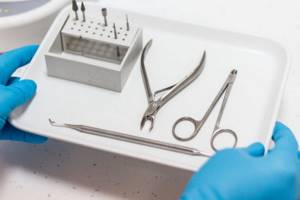
During the procedure, the specialist:
- Conduct a visual inspection of the nail and determine what type of deformation you are experiencing;
- Removes keratinization, cuticle and cleans side ridges. Polish the nail if there are no contraindications;
- He will prescribe treatment with ointments and creams or refer you for a consultation with a surgeon.
Nail deformation is most often a consequence of:
- Lack of vitamins and poor nutrition;
- Serious injuries to the nail bed;
- Congenital anomalies;
- Past dermatological diseases.
Lyudmila Sheveleva
Doctor, pharmacist
Ask a Question
You will be interested to know that nails become deformed due to frequent contact with: detergents and cleaners, fertilizers, solvents and other aggressive substances. Often their shape changes as a result of frequent extensions and the use of decorative coatings of dubious quality.
Onychomycosis
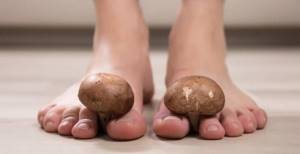
Onychomycosis is a fungal infection of the nail plate and adjacent skin.
To determine the disease, it is not enough to rely only on changes in the appearance of the nail, so a trip to a medical pedicure to a master podiatrist is simply necessary.
In clinics, scrapings are taken to confirm the diagnosis and examined using a microscope. Inoculation of the studied material on nutrient media is also practiced.
After the fungus is confirmed, a hardware medical pedicure is performed:
- Removal of the damaged area of the nail with a milling cutter by filing it down;
- Cleaning the remaining surface of the nail, as well as treating nails not affected by fungus;
- Application of antifungal drugs;
- Consultation on the prevention of recurrence of onychomycosis.
After a medical pedicure to treat fungus, it is not recommended to apply a decorative coating to ensure air access to the affected area.

Symptoms indicating the possible development of a fungal infection:
- Change in color of the nail plate - from reddish to gray;
- Partial destruction of the damaged area;
- Thickening in the affected area;
- Increased nail fragility and ability to crumble;
- Separation of the horny plate from the nail bed.
Prevention of the appearance and development of fungal infections;
- Don't wear someone else's shoes;
- Do not walk without shoes in public places - swimming pools, saunas;
- Do not wear low-quality shoes, as well as synthetic socks and tights;
- Contact a specialist promptly at the first manifestation of symptoms.
Green nails and pseudomonia disease: causes, diagnosis and treatment options
Classic pedicure
One of the most popular ways to take care of the health and beauty of your feet is a classic pedicure, also called a trim pedicure. It does not require the use of a special set of tools and is always done after thoroughly steaming the legs.
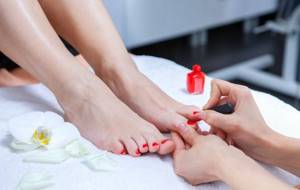
How to do a classic pedicure:
- feet are immersed in a bath of warm water, in which soap or salt have previously been dissolved (if there are no problems with the skin condition), citric acid (if the plates require whitening), salicylic acid (for more intense softening), herbal decoctions (to soothe the skin and speed up healing wounds and scratches);
- using a scraper, pumice stone, or a special file for grinding varying degrees of hardness, keratinized skin and corns are removed;
- The cuticles are cut using nippers, and the plates are given the desired shape.
Advantages of a classic pedicure:
- the price is lower than other varieties;
- the service is provided in any pedicure salon;
- Can be done at home;
- instant tidying up of the nail bed;
- Removing keratinization after steaming allows you to achieve the softest effect.
Disadvantages of classic pedicure:
- high probability of skin damage;
- the possibility of infection from a cut;
- short-term results, since after softening the cuticles and corns, regeneration processes are activated, forcing the cut areas to quickly recover;
- the master can cut off the excess, after which it will hurt to step on your foot.
Main types
Classic edged
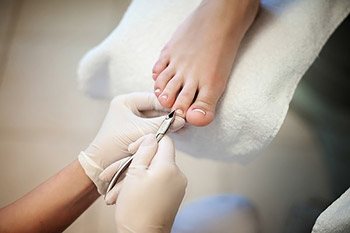
This is the most ancient type of pedicure, which is already more than 100 years old, so it has “overgrown” with its own characteristics. First, the feet are steamed in warm water with the addition of sea salt, herbs and soap. Then the nails and cuticles, soft after water, are trimmed with scissors, and the feet are cleaned with scraping devices .
This type is suitable for doing it yourself at home, but it is the most dangerous, since you can easily get hurt or cut with sharp instruments.
European unedged (dry)
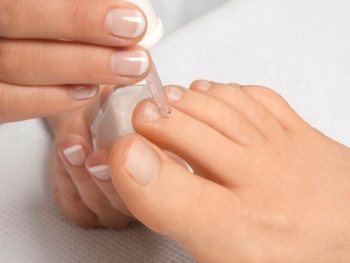
This pedicure is considered a subtype of the classic one, but unlike it, it is done on dry feet. This does not mean at all that the client will experience discomfort during the procedures: all manipulations are painless and even pleasant.
The cuticle is not cut, but treated with a special substance that softens areas of the skin and slows down its growth. Then it is simply moved to the edge of the nail plate . The keratinized growths on the feet themselves are removed using softer means - scrapers or graters. This pedicure can also be done at home on your own, but to get rid of cuticles completely, you will need 8 to 10 regular treatments.
Japanese unedged
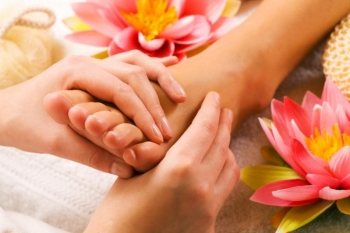
The legs are treated with an antibacterial agent, the cuticle is pushed back using a tachibana , and then it is lubricated with cucumber extract. Then it is softened with minerals, and a scrub is applied to the feet. Then the feet are immersed in aromatic baths.
The nails are buffed with a rice block until they have the perfect shape. To stop the cuticles from growing or to reduce the growth rate, they are treated with lotus oil . The legs are covered with beeswax powder , and the feet are smeared with a solution based on citrus essential oil . This helps rejuvenate and tone the skin on your feet. The final stage of the pedicure is a relaxing foot massage and medicinal herbal masks.
Fish pedicure
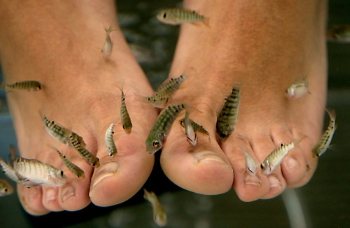
Pedicure as part of natural peeling. The client simply dips his feet into an aquarium where fish doctors of the Garra Rufa breed , feeding only on dead cells. With their mouths in the form of suction cups, the fish absorb all excess and keratinized areas of the skin , while delivering pleasant sensations to the client.
This is the best choice if you decide not only to take care of your feet, but also to rejuvenate them. Most often, this procedure can be seen in hot tourist countries right on the beach; the fish themselves come from Turkey, Japan or China. They are almost never full, so pedicurists can work almost without breaks. Such fish are not suitable for home breeding: without constant “feeding” their ability to cleanse the skin is lost.
Brazilian pedicure
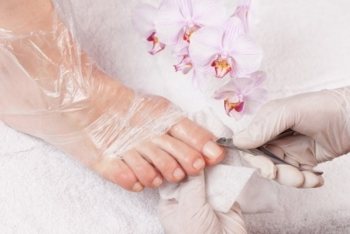
This is a simple innovative procedure that came to us from Brazil. It saves time and effort, it can be done without skills, independently, at home. Special cellophane socks are put on your feet , which soften the entire stratum corneum of the skin, remove calluses and corns, and most importantly, lift the cuticle. For one procedure, 10-15 minutes are enough.
Brazilian pedicure also has healing properties:
- heals microcracks;
- relaxes and tones the skin of the feet;
- accelerates metabolism and nail growth;
- activates blood circulation;
- relieves irritation and kills infections.
SPA pedicure
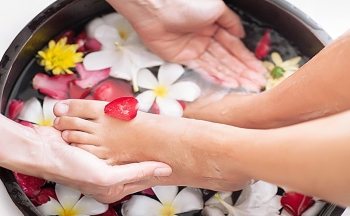
It is used for those clients who want not only to get well-groomed and beautiful legs, but also to completely relax and have a lot of fun. There are no cutting tools or hardware cutters in this pedicure. The main action comes from scrub, sea salt, mud, creams and lotions . Algae concentrates from the Dead Sea are also used .
Cuticles are removed with alpha hydroxy acids, calluses and rough dead tissue are removed using sea serum and scrubs. The entire procedure takes place under calm, relaxing music, the legs are massaged, and the pleasant smells of incense spread throughout the room. The final stage is a therapeutic mask, which in summer can have a cooling effect (mint).
Medical pedicure
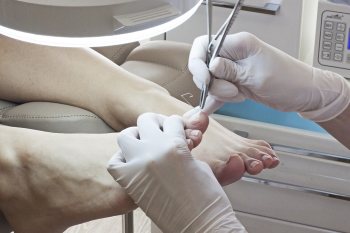
The procedure is largely therapeutic and can only be performed by a specialist with a medical education . During it, the master even treats infections, if any.
First, the feet are treated with an antiseptic, then softened with special means, and cleaned of keratinized growths. The nail plate is given the desired shape, the surface is sanded, treated with antibacterial substances and, if desired, varnished by the client. The feet are massaged with nourishing creams that tone the skin of the feet.
Liquid pedicure (fruit-acid)
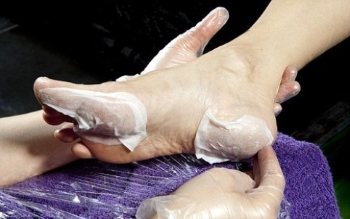
These treatments are performed using a chemical called liquid blade (commercially available) which helps soften skin tags and promote rapid regeneration. The product works only on rough skin, without touching healthy skin. Regular use of liquid pedicure will have a healing effect and completely relieve you of cracked heels . The procedure can be carried out both in the salon and at home.
The solution contains the following acids: glycolic, vegetable and fruit, lactic. Therefore, such a solution is easy to prepare even on your own. After the feet have been in the substance for 10-15 minutes, all exfoliated growths can be removed with a nail file or grater, treated with an antiseptic and lubricated with a nourishing cream.
Hardware pedicure
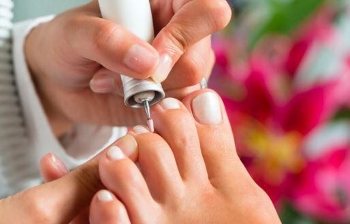
Hardware cosmetology has reached our feet, so we can bring them into ideal condition with the help of special cutters. They will carefully and without the risk of infection and injury remove all dead skin layers using different cutter attachments . Before the main procedure begins, the feet are treated with special softening agents. In this case, the removal of healthy skin is completely excluded, and the end result will surprise you with its duration.
Men's pedicure
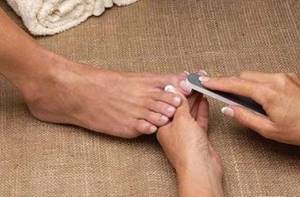
It is no different from women’s, so it can be performed in any of the above ways. The only difference is that men do not cover their nails with bright varnishes, but choose a transparent or simply protective base. For a master, a man's pedicure is a little more difficult than a woman's due to the increased size of the foot and rougher skin.
Children's pedicure
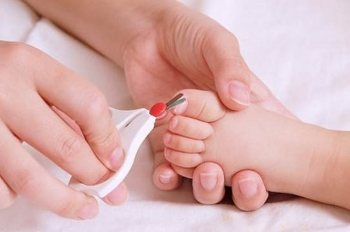
The procedure consists only of correctly cutting the nails with scissors with rounded ends. The main thing here is not to cause an infection and not to cut off the corners, so as not to get rid of the ingrown nail later. The best time for a children's pedicure is after a bath, when the nail plate is softer and more pliable. The salon can also use hardware pedicures for children.
Medical pedicure
This type of foot care is performed only by professional podiatrists who have undergone special training. The procedure is done after consultation with a doctor who has identified a dermatological or surgical problem: fungus, increased sweating, ingrown nails, warts, etc.
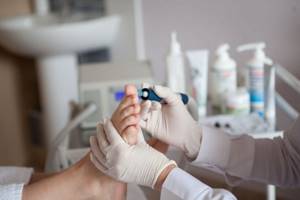
The essence of the procedure is that, using modern devices for removing dead skin, the doctor relieves the patient of the disease and puts his nails in order. The skin of the feet is softened with special lotions and creams; steam baths are not used. Depending on the lesion, not only the cuticle, but also the nail plate can be removed.
Step-by-step instructions:
- Foot treatment. Before starting the procedure, the doctor disinfects the feet with an antiseptic. This prevents the penetration of bacteria and also helps fight fungus.
- Softening by applying special products to the entire surface of the foot.
- Hardware removal of dead skin. The doctor selects the right attachment, removes dead cells, treating each finger and problem areas.
- Working on the nail plate. The podiatrist polishes the nails, processes the cuticles with a device, and, if necessary, shapes the nail bed with a file and other devices. Some diseases require partial or complete removal of the plate, which is then replaced by a temporary prosthesis.
- Applying masks and creams. To consolidate the result, the legs after the procedure are cleaned of epithelial remnants and covered with restorative agents. Sometimes antifungal varnish is applied to the nail plates.
Read more in the article: “Medical pedicure: indications and features”
Medical and classic pedicure: about the differences and features of the procedures
Well-groomed legs not only look attractive, but also increase self-confidence and make you feel younger. And the main component of care is pedicure. Moreover, in this case we are talking not just about covering the nail plate with a bright color, but, above all, about the correct treatment of the nails and skin of the feet. This procedure can be carried out using a classic or medical pedicure. And if you think that these procedures are the same, then in this article you will discover a lot of new things.
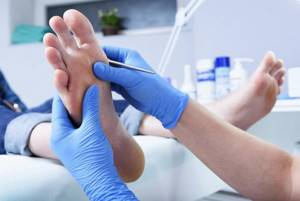
Description of procedures: what is common and what is not?
Classic and medical pedicure are procedures that involve treating the feet. In principle, this is the only thing that unites them. Otherwise, the services differ radically from each other: Classic pedicure
– an aesthetic and hygienic procedure that involves treating the nail plate, eliminating minor skin imperfections, coating the nails with varnish, softening the dermis with peeling and scrubbing.
Medical pedicure
is a professional pedicure performed by a podiatrist, aimed not at short-term elimination of skin imperfections, but at the full treatment of various types of diseases - corns, calluses, cracks, ingrown nails.
For clarity, we will give an example of treating an ingrown toenail. With a classic pedicure, the master simply straightens the overgrown nail plate (if possible); with a medical pedicure, the podiatrist corrects the direction of nail growth by installing a special system of staples or removes the plate altogether. This happens in extremely advanced cases when the non-surgical method is powerless. At the same time, medical pedicure does not end with the work of a specialist. To maintain the achieved result, the client will have to use the medications prescribed by the podologist for some time - ointments, tablets or baths on his own.
Medical and classic pedicures can be compared with professional teeth cleaning and daily cleaning at home. It is unlikely that in order to remove the hated plaque or formed caries, you will simply brush your teeth more often. In such a situation, it is more effective and correct to contact a specialist. The same thing happens in the case of medical pedicure.
Techniques for medical and classic pedicure
Many clients mistakenly believe that hardware pedicure is medical. This is wrong. The service performed using a special machine is a type of aesthetic and hygienic procedure. During the procedure, the master uses a standard pedicure set: tongs, files of varying hardness, skin softeners, scrubs, etc. A classic pedicure is performed by a qualified specialist in the appropriate field. As for medical pedicure, in this case the podiatrist uses a professional apparatus equipped with disposable abrasive attachments, machines with blades of various thicknesses, creams and ointments with a medicinal composition, as well as special tools - correction brackets if necessary. In terms of preparation and format, such a procedure is more like a full-fledged doctor’s appointment. Medical pedicure is performed only by a specialized podologist.
Indications for both procedures
Most of the differences between classic and medical pedicures concern the problems that these procedures can combat. For example, the main indications for standard pedicure
procedures are considered: • Thin cuticle; • Microcracks on the heels; • Corns; • Dry skin; • Peeling nails; • Hangnails; • Uneven nail plate.
An important indication for a classic pedicure is the aesthetic transformation of the legs. Usually, the main purpose of such a procedure is to cover the nails with gel. For this reason, it is carried out on a regular basis and as needed.
In the case of medical pedicure, indications
to be carried out look a little different: • Fungal skin infections; • Ingrown nails; • Deep and constantly occurring cracks; • Deformation of the nail plate or finger; • Foot injuries; • Thickening of the nail; • Hyperkeratosis; • Too dry skin; • Presence of diseases that worsen the condition of the foot - arthritis, diabetes.
You should seek the help of a podiatrist if you experience inflammation and pain in the nail area, the appearance of corns, warts, itching, unpleasant odor, changes in the color of the nail plate, or deterioration of the skin condition. For preventive purposes, a visit to a specialist usually occurs after a full treatment program for a specific disease. Performing medical pedicures on a regular basis is not practiced, because... Frequent deep treatment of the feet can have a detrimental effect on their condition.
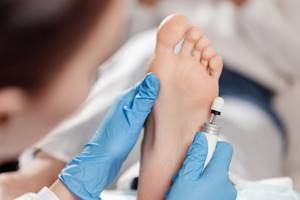
Contraindications: when should you not perform a classic or medical pedicure?
Foot treatment procedures differ according to the list of contraindications: Classic pedicure:
• Skin damage in the treatment area; • Excessively sensitive and/or thin cuticle; • Skin inflammation in the active stage of development; • Serious damage to nails; • Diabetes; • Blood clotting disorders; • Ingrown nail at the 2nd or 3rd stage of development.
Medical pedicure
• Infectious lesions of the feet in the acute stage; • Open wounds in the treatment area; • Allergy to drugs used during treatment; • Hemophilia; • Neoplasms on the feet; • Acute form of dermatological diseases.
If we exaggerate all the contraindications, we can conclude that diseases that a pedicurist cannot cope with should be addressed to a podiatrist. In this case, the possibility of carrying out a particular procedure is established only during the initial examination. In our cosmetology center, consultation before performing the service is free of charge. During its implementation, a specialist may prescribe individual tests. Also at this stage, the presence of chronic diseases and allergies is clarified.
Differences in the process: the main stages of a pedicure
A classic pedicure performed by a master begins with cleansing the nails of the old coating and steaming the feet. After this, the roughened areas are treated with pumice. If we are talking about a hardware pedicure, then in this case special cutters are used, and the steaming stage is skipped. The next step is to soften, lift and trim the cuticle. Next, the specialist softens the skin using cream or oil at the client’s request.
When performing a medical pedicure, the procedure is
a bit different. There are 6 main stages of this procedure: 1. Treating the feet with a softening agent - makes rough skin more elastic and pliable; 2. Grinding rough areas with cutters - thanks to attachments of different shapes, hardness and sizes, the podiatrist can easily reach each area; 3. Softening treated skin with cream, oil; 4. Application of medicinal cream - against dryness, mycosis, cracks - depends on individual problems; 5. Relaxing massage - increasing blood flow by lightly massaging the feet; 6. Covering nails with a classic coating or a special composition - medicinal varnish contains a large amount of calcium and other useful microelements.
At the same time, the exact procedure for performing a medical pedicure depends on the initial problem and individual characteristics. In the case of an ingrown nail, the installation of staples that correct the shape of the nail plate will be added to the main stages.
General stages of procedures
But there is something in common in performing classic and medical pedicures: • Disinfection.
Each procedure begins with a thorough disinfection of the feet.
This stage is necessary in order to prevent possible penetration of bacteria under the skin, including into the cuticle. • Nail coating.
At the client's request, a pedicurist or podiatrist can cover the nail plate with gel or regular varnish and then create a design.
A classic pedicure takes from 40 minutes to 1 hour. It is recommended to carry out this procedure every two to three weeks. Medical treatment of the feet, in turn, takes a little longer - the standard procedure is about 2 hours. It should be performed only if indicated. It should be taken into account that in some situations, a medical pedicure may imply a full course of treatment, consisting of several sessions.
Let's talk about the main thing: the benefits of medical and classic pedicure
Ensuring the beauty and health of feet is the main advantage characteristic of both medical and classic pedicures. But in other advantages, these procedures are slightly different: Classic pedicure:
• Fast execution speed; • Relatively low cost; • Instantly noticeable effect; • Maintaining the result for a long time; • Ability to eliminate minor skin defects.
Medical pedicure
• Therapeutic effect and the ability to eliminate the “root” of the disease; • Painless removal of skin imperfections; • Prevention of the development of skin diseases at their early stages; • Minimum likelihood of spreading fungal infections; • Thorough and camphor cleansing of feet; • A complex approach.
It is difficult to identify any imperfections in the treatment of feet, provided that the procedures are followed correctly and sterile instruments are used.
Classic and medical pedicure – what to choose?
There is no need to choose between a classic and medical pedicure. These procedures perform different tasks and cannot be placed on the same level.
Before visiting a podiatrist or pedicure service, you should take a good look at your feet and understand what exactly doesn’t suit you. If your feet are healthy and you just need to clean the cuticles and touch up the nail plate, a classic pedicure is for you. But to eliminate cracks, warts, fungus, and ingrown toenails, it is better to consult a podiatrist.
The specialists of our cosmetology center will help you understand which specialist you need at a preliminary consultation. We can perform both classic and medical pedicures depending on your wishes.
Sign up for a free consultation with a Podologist. May your feet be healthy and beautiful.
Hardware pedicure
A pedicure done with the device allows you to consolidate the results for a long time. It belongs to the “dry” types of foot treatment, as it does not require preliminary steaming. The procedure is performed with a machine with a large number of attachments, cutters and caps. The master himself selects the right tool, based on the condition of the legs.
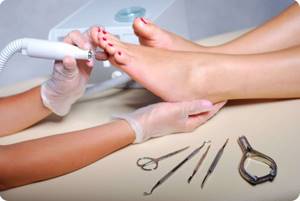
The essence of the procedure is to use a device with a nozzle rotating at a speed of up to 50 thousand revolutions per minute to painlessly rid the feet of rough skin. Cuticles are processed according to the same principle without previous softening.
Advantages of hardware pedicure:
- injuries and cuts are minimized;
- speed of implementation;
- elimination of problems that are not possible with the classical procedure;
- lasting effect up to 4 weeks.
Disadvantages of hardware pedicure:
- if the treatment is performed by an incompetent specialist, he can cause serious harm to the skin;
- relatively high price;
- an unpleasant burning sensation in people with sensitive skin and thin nail plates.
Read more in the article: “Hardware pedicure: how it’s done, pros and cons.”
Cost of the procedure

Average prices for individual medical pedicure procedures:
- Removal of fungus from one nail from 1,000 to 3,000 rubles;
- Treatment of deep cracks - from 600 to 2,000 rubles. for one break;
- Installation of a bracket to correct an ingrown toenail – from 2,000 to 6,000 rubles;
- Correction of a previously installed brace - from 1,500 to 3,000 rubles;
- Treatment of calluses – from 2,000 to 11,000 rubles. depending on the degree of neglect;
- Removal of corns - from 2,000 to 7,000 rubles.
- Consultation with a qualified medical pedicurist in different institutions ranges from 1000 to 4000 rubles.
- In addition, some organizations carry out visits to the client’s home. This service is relevant for older people and people with disabilities. The cost of departure varies from 1000 to 2500 rubles. without taking into account procedures.
Please note that the prices presented are relevant for Moscow and St. Petersburg. Depending on the region and level of the salon or medical center, the cost varies significantly.
European pedicure
Foot care according to the European method involves the use of the latest achievements in the field of cosmetology. The cuticles are treated with a composition that dissolves them within 10-15 minutes. Subsequently, they will no longer be so hard; the product helps soften them for a long period of time.
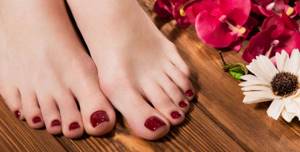
The essence of the procedure is that the master applies a special gel to the cuticles and corns to soften them. He then uses an orange pusher to push back the skin, revealing the nail bed. To process the feet, graters and grinders are used.
Advantages of European pedicure:
- speed of execution, since steaming is not necessary;
- maximum skin safety;
- Only the roughened epithelium is removed, the “living” skin remains intact.
Disadvantages of European pedicure:
- the use of low-quality cosmetics can lead to nail diseases;
- the effect does not last long, the cuticle quickly loses its well-groomed appearance;
- the soles of the feet are not as soft and smooth as after a classic pedicure.
Beautiful pedicure - I'm at your feet
The history of pedicure goes back hundreds of thousands of years. Years filled with a lot of interesting events, small victories and big discoveries. In fact, a pedicure is a manicure on the feet and the etymology of this word is also not particularly original (“pedis” - “foot” and “cure” - “care”). There are reports that even Queen Cleopatra, who ruled in Ancient Egypt, had specially trained slaves who massaged her feet and washed them with aromatic water and essential oils. In Ancient Rome, the tradition of care continued, because people realized that there is an unlimited number of nerve endings on the legs that stimulate the work of the whole body.
The situation turned upside down in the dark times of the Middle Ages, when any manifestations of caring for oneself were ashamed by the church and rejected by “pacification of the flesh.” It was only during the Renaissance that pedicure again became a given hygiene ritual. The first “specialist podiatrist” was the Englishman David Lowe, who founded a special hotel in 1774 where calluses were trimmed for sufferers. Thanks to her work, she even wrote the book “Chiropodology”, where she collected all the accumulated knowledge in the field of foot health.
In 1830, the so-called “Sitts method” appeared, invented by an American doctor and involving careful treatment of not only nails, but also the skin around them. The year 1868 was marked by a real breakthrough - the German pharmacist Eduard Gerlach released a foot cream developed for soldiers, which marked the beginning of the production of the first pedicure cosmetic line of products. At the beginning of the twentieth century, pedicurists even had their own school, opened in New York, where they taught all the wisdom and secrets of practicing specialists. It is not surprising that the history of pedicure is closely intertwined with the history of manicure, because all innovations smoothly migrated from one industry to another and vice versa. Nowadays pedicure is a popular service, indicated in the price lists of any beauty salon around the world. But ProstoNail believes that you can get a fashionable pedicure this season at home. What is needed for this? Hurry up to save your sign.
| Tool name | What is it used for? |
| Pusher | Metal stick with a flat working edge. Suitable for pushing back cuticles and freeing the nail bed from overgrown epidermis |
| Glass, fabric or iron nail file | Perhaps the most important tool for giving your nails the desired shape and removing excess length. They are divided by the amount of grit, that is, by the degree of abrasiveness: 900-1200 g - for polishing natures. nails, 200-400 g - to give shape to nature. nails, less than 180 g - only for extended nails |
| Scissors and/or tweezers made of hardened, corrosion-resistant steel | Basic manicure tools can be used not only to cut off excess length, but also to eliminate cuticles. It is advisable to purchase accessories made of surgical steel |
| Medium-sized plastic tub or bowl | Of course, you can use any other bowl as a cosmetic bath, but for a “salon ambiance” it’s worth spending once on a highly specialized accessory |
| Wooden orange stick | Sold as a set. Especially relevant for those girls who prefer an unedged manicure method. Used for pushing back cuticles and minor correction work |
| Soft buffs for polishing | It is better to have several in mind because they wear out quickly. They are made from both natural (suede) and synthetic materials. Helps polish and straighten wavy nail plates |
| Pusher | Metal stick with a flat working edge. Suitable for pushing back cuticles and freeing the nail bed from overgrown epidermis |
| High-quality lamp for working with gel polish | For polymerization of gel polishes. A more budget-friendly option is an ultraviolet lamp, a more “long-lasting” and practical option is an LED lamp. |
| Brushes | Using brushes, making various designs on your nails is a matter of a couple of minutes. For a basic home collection it is quite enough: a thin synthetic hair brush, a flat brush, a petal brush and a fan brush |
| Dots | A metal or plastic stick with round ends used for placing dots in basic patterns |
As you can see, doing a fashionable pedicure at home is quite possible, and it also saves your time and money. For especially doubtful and critical ladies, ProstoNail has prepared a list of reasons explaining in detail why you should dare to undergo such a popular procedure:
- Pedicure is not only a catchy nail design, it is also care for the skin of the feet, which receives the most stress during the day. The epidermis on the heels tends to harden and, as a result, cracks and painful wounds form in this place. By polishing, scrubbing and polishing the skin you will avoid problems when walking and discomfort;
- since the feet have a huge number of nerve endings, foot massage can have a beneficial effect on the body as a whole;
- beautiful, well-groomed legs are an essential component of a woman’s image, serving as an indicator of neatness and caring attitude towards oneself;
- if you do not perform weekly hygiene procedures on the skin of your feet and toes, you risk developing calluses and corns that spoil the quality of your life;
- correct cutting of cuticles and processing of the side ridges around the nails guarantees the absence of ingrowth;
- A pedicure is time that you can devote to yourself and harmonize your inner feelings.
By the way, there are many types of pedicure in the world, we have collected the most popular of them:
- hygienic pedicure is a routine procedure of trimmed or untrimmed pedicure, which is characterized by a warm foot bath, cuticle correction and removal of excess nail length;
- Pedicure stone massage is one of the types of pedicure for relaxation and complete recuperation. When implementing it, heated stones are used to massage the feet;
- mini-pedicure - as a rule, this is offered in many express service salons. This does not include a foot bath and/or removal of rough skin. Sometimes called “pedicure fingers”;
- SPA pedicure is perhaps the most pleasant type of foot care. Clients are offered not just hygiene procedures, but also paraffin therapy, application of cream or mask, body wrap or chocolate massage;
- sports pedicure - somewhat similar to a toe pedicure, but in this type of care the skin of the feet also receives thorough polishing. In addition, the nails must be covered with a transparent or nude varnish.
We are sure you no longer have any doubts. Warm water with salt is cooling in the bath, all the tools are sterilized and waiting in the wings, all that remains is to choose a pedicure design. ProstoNail will not leave its faithful readers in the throes of doubt. Look carefully at the colorful pictures and save your favorite options.
Japanese pedicure
The Japanese way of caring for the skin of the feet is to use a variety of natural-based products at each stage of the procedure. Its essence can be seen in the following stages:
- Antiseptic treatment.
- Applying scrub, rubbing with pumice.
- Apply cucumber extract to the cuticles and massage each finger.
- Polishing the nail plate.
- Rubbing the vitamin solution into the nail.
- Treat each nail with wax and paraffin.
- Covering the skin of the fingers with scented oil.
- Massage the entire foot with a special silk bag with salt and herbs.
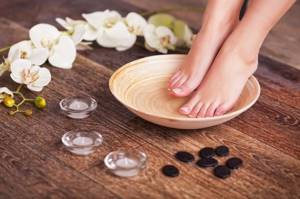
Advantages of Japanese pedicure:
- painless;
- the possibility of damaging the skin is minimized;
- The whole body relaxes, not just the feet.
Cons of Japanese pedicure:
- there are few craftsmen who master this technique;
- high price.
At home, Japanese pedicure socks, which are plastic bags filled with a treatment agent, are popular. They are easy to use: just put them on clean, dry feet and leave them on for about 1-2 hours. Then they need to be removed and the feet should be washed thoroughly. The effect becomes noticeable a week after the procedure.
Who is suitable for a combined pedicure, its technology
If you don’t like the classic system with steaming in a bath, hard brushes and cutting the cuticles with sharp scissors, then a combined pedicure is for you. In addition, if you have not treated your feet for a long time, there are painful calluses, cracks, the cuticle has grown, the nails have become brittle, then the master’s work will require a combination of several techniques.
On the other hand, there are clients who do not like European pedicures with unedged techniques. They believe that it does not cope well with rough skin on the feet. The master needs to be able to make combinations for any, even very advanced cases. Fortunately, there are enough options and means for this.
With a combined session, the likelihood of injury to the foot and toes is minimal. Those who have sensitive, thin skin can perform a pedicure with heating in a bath, scrub treatment, massage, but without the use of sharp metal objects. And those who prefer untrimmed technology can turn to the effective methods of the classic version: after hardware grinding and softening, cut off the cuticle.
Read the material on the topic: How to strengthen peeling nails
SPA pedicure
A spa treatment involves relaxation of the whole body. Scented candles, incense, relaxing music - everything contributes to complete relaxation.
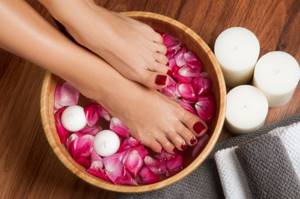
The essence of this pedicure is that dead cells are removed with soft scrubs, lotions, creams, and gels. Mechanical tools are not used. The applied products take a long time to be absorbed, you need to wait until they begin to act. After the SPA, masks with sea minerals are always applied to the feet.
Pros of SPA pedicure:
- the whole body relaxes;
- the risks of injuring the skin and causing infection are minimized;
- lasting effect.
Disadvantages of SPA pedicure:
- high price;
- the skin of the feet is rougher than after a trim pedicure.
Principles and sequence of combined pedicure
Basically, specialists make up a combination of hardware pedicure, classic trim and elements of SPA care. First of all, foam, essential oils, soap balls or a special composition for maceration are added to a bath of warm water. After softening the skin of the feet, they are massaged with various scrubs (sugar, salt, mineral) and rinsed.
The next step is to remove the layer of rough outer skin on the feet and heels with a pumice stone or a special grater. To avoid cuts, you need to take precautions. If injury does occur, it is necessary to quickly treat the area with hydrogen peroxide or a hemostatic pencil.
For clients who prefer soft grinding, we can offer whetstones with a rough surface or equipment with different attachments. Dry skin needs to be treated. Otherwise, you can injure it or cause a hangnail to appear. You can also change attachments on the device and alternate them with files.
First, use a tool with a coarser abrasive to remove the topmost layer of cells. At the next stage, bring the area smooth with soft brushes, smooth and polish the feet, fingers and the space between them. A special machine is used to cut calluses. The blades on it are changed for disinfection.
You can avoid steaming in hot water if you don’t like it. Instead, the specialist will suggest chemical peeling, that is, softening using a cream with fruit acids. In just five to seven minutes, the skin becomes looser on top, and can be removed with a brush and rinsed. This stage is mainly suitable for those who do pedicures regularly and whose dermis is not too rough. But you can deal with it differently: first, carefully scrape off the dead skin, and then apply a gel with acids. It is necessary to strictly observe the exposure time so as not to burn your feet.
Processing or cutting the cuticle is the next step. A softening cream, gel or pencil with a special composition is applied to the skin around the nail. Then, with a metal pusher or an orange wood stick, it is pushed aside for cutting with wire cutters or nail scissors. If you used a bath and the skin is soft, you can remove it without cuticle liquid.
After removing the cuticle, rinse your fingers and wipe dry. For nutrition and greater softness, a cream containing urea is applied to the feet. After cleansing, the skin especially needs nutrition and hydration.
The next stage is nails. To prevent delamination and ingrowth of the nail plates, you need to shorten the overgrown edge evenly with flat-cut pliers or tweezers. To process brittle and brittle plates, it is better to take a coarse-grained cardboard or ceramic file. For final polishing, a hardware pedicure with special attachments or a manual pedicure with polishing bars is suitable. Or use a fine-grained glass file.
So, you need to choose a combined pedicure if:
- you think that the hardware only “strokes”;
- you have sensitive skin, you are afraid to injure it with a classic trimmed pedicure;
- the cuticle grows on the nail, it is difficult to remove it with a device;
- It is necessary to remove corns and calluses.
The use of the device and conventional instruments gives the best result, regardless of the initial condition of the feet. SPA treatment can provide additional care thanks to natural extracts and herbs.
Read material on the topic: Curvature of the nail plate
Pedicure at home
At home, it is recommended to perform only classic trimming care, for which you will need:
- container for steaming legs;
- pedicure set with scissors, nippers, tongs, pusher, etc.;
- devices for treating feet (pumice stone, grater, etc.);
- nailfile;
- moisturizing cream;
- towel.
How to do a home pedicure
The procedure for performing a home pedicure consists of the following steps:
- Immerse your feet in a bath of warm water for 10-15 minutes.
- Dry your feet and use tweezers or scissors to shorten your nails.
- Use a pumice stone or a grater to remove keratinized epithelium on the feet, paying special attention to the heels and the skin between the toes.
- Trim the cuticle with nippers, using repeated gentle movements to move the remaining skin with a wooden spatula, opening the nail plate.
- File your nails and give them the desired shape (square will help avoid ingrown nails).
- Apply moisturizer.
- If desired, varnish.
What is included in a pedicure?
Despite the different approach to treating feet in each method, there are common tasks that are aimed at obtaining the ideal condition of the feet and nail plates.
All pedicure procedures include the following manipulations:
- cleansing nails of old varnish or plaque;
- cuticle removal;
- full foot treatment;
- cutting or filing nails to the correct shape;
- eliminating cracks;
- removal of keratinization, calluses and corns;
- healing of ingrown nails.
Many types of pedicure also consist of polishing, nail extensions, peeling or scrubbing, bathing and other beneficial procedures.
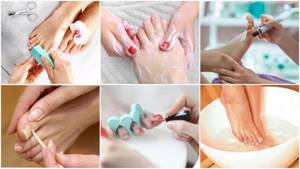
Manipulations for different types of pedicure
Calluses and cracks
A large load on the feet, combined with improper care, leads to the formation of calluses, corns and cracks of varying depths on the feet. With minor manifestations, such problems can be dealt with at home. To do this, you need to take evening baths every day, adding restorative solutions to the water.
If the thickness of the dead epithelium is so great that pain appears when walking, then you cannot do without a visit to the pedicure salon. The specialist will assess the extent of the damage and suggest appropriate treatment.
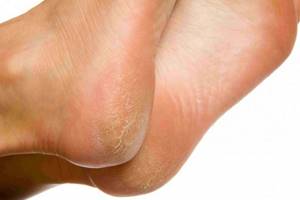
Advantages and disadvantages of combined pedicure, contraindications
Advantages of a combined pedicure:
- It allows you to remove many of the problems that visitors come with: small cracks, ingrown toenails, which very often annoys you when walking, rough skin, large cuticles. Corns and calluses disappear after a bath and treatment with a device with attachments.
- Even if this is your first time visiting a beauty salon specialist, a combined manicure or pedicure will immediately correct many shortcomings. The effect lasts for almost a month.
- A combined pedicure session lasts from an hour to two. It all depends on the condition of the patient’s legs, the skill and professionalism of the specialist. The approach is individual, the combination of techniques may vary.
- SPA care, masks and application of varnish and drawings are additional steps. Time is allocated for them separately from the main procedure.
Features and disadvantages of combined pedicure
Classic and combined pedicure - what's the difference? And what is the difference between a hardware pedicure and a combined one? Let’s answer this: women who consider these methods individually insufficient prefer to combine. They want the best of both worlds. The effectiveness of this option is higher, the comfort and softness of the feet last longer.
To perform a combined pedicure, you need to be an experienced master, go through a certain school, have certificates and diplomas of completion of training. Some beginners adhere to the rule: “Do not sand on wet feet.” It is better to go to recommended specialists. Follow the principle: “Trust, but verify.”
A distinctive feature of the combined pedicure are SPA elements. That is, the master uses essential oils, creams, gels based on natural ingredients (fruit acids, herbal and plant extracts). Accordingly, they are more expensive.
A specialist can offer different combinations and replace them as agreed. For example, take a scrub with large grains instead of hardware exfoliation. Or use both.
Each person is individual. There are always contraindications.
So, a combined pedicure should not be done if:
- the client is sick with diabetes, viral hepatitis;
- there are malignant tumors;
- blood does not clot well;
- there is a fungal infection on the legs;
- weak immunity;
- you are currently pregnant or breastfeeding;
- there is an allergy to drugs;
- there are viral infections in the blood;
- liver or kidney diseases are observed.
Procedures supporting pedicure
After a visit to the salon or home care, you need to carry out maintenance procedures to maintain the effect. At least twice a week, feet should be moisturized with creams based on soothing herbs. Scrubs designed specifically for feet and containing apricot, almond, etc. kernels will be useful. Peeling with their help should also be done at least 2 times a week.
A good way to prevent keratinization of the skin of the feet is to wear comfortable shoes made of high-quality materials that prevent excessive sweating.
How often should you get a pedicure?
And here again there is no single option. As a rule, specialists advise contacting them at least once every 3-4 weeks. But if you have soft and moisturized skin that does not require regular care, you don’t need to go that often. Visit a specialist as needed as soon as your feet begin to harden.
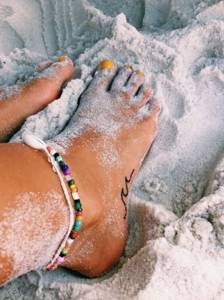
Pedicure tools
The procedure includes caring for the nails and skin of the feet, so to perform it you will need not only a pedicure kit, but also equipment for treating the feet.
Rules for choosing a tool
When choosing tools for a home pedicure, you need to pay attention to:
- material - metal objects must be made of stainless steel; if it is a file, then, on the contrary, it should not be made of metal;
- quality - you need to check the manufacturer: read reviews about it, study the official website;
- size – items should be compact and easy to use;
- sharpening - only sharp tools will help achieve the desired effect;
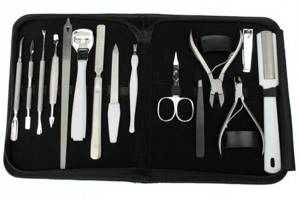
Varieties of basic pedicure tools
There is no strict classification of items for pedicure, but they are usually divided based on the purpose of use:
- to tidy up the nail plate;
- for processing cuticles;
- to remove roughened epithelium and polish the foot;
- to eliminate problems such as fungus, ingrown toenails, calluses, etc.
The main tools for foot care are:
- scissors - preferably with straight ends, since you need to cut in a straight line;
- nippers - used both for shortening the nail and for cutting cuticles;
- tongs – cut thick nails;
- files – different types are required: coarse-grained, grinders, buffs, polishers, etc.;
- pusher - helps to push back the cuticle;
- scraper – removes dead skin from the heels;
- pumice and graters also remove keratinized epithelium.
Pedicure is an important procedure that performs both aesthetic and therapeutic functions. If you have calluses, corns, ingrown toenails or foot problems, it is better to consult a specialist.
New pedicure products
In the last few years, quite exotic types of pedicure have appeared:
- Thai
– soft peeling of the feet, relaxing massage, as well as moisturizing, nourishing and softening the skin of the feet with special balms containing oils of eucalyptus, cumin, lime, cocoa, etc. - Chinese
- peeling with socks made of polymer material, which contain a cream to soften rough skin. Socks are put on the feet for 1.5-2 hours, and within 2-3 weeks the rough skin gradually disappears, leaving a young, tender dermis.
As you can see, there are more than enough types of pedicure. In this rich list, there is probably one that suits you more than others. Which one you prefer is not so important. The main thing is that you do not forget about your working legs and take care of their health and well-being.
Get a pedicure every 3-5 weeks, and they will serve you faithfully for many years, look amazing and attract the admiring glances of men.
Moreover, in salons you will find dozens of offers for nail design. The main thing is to remember that all this nail-art is a decoration only if your legs and nails are brought to impeccable condition!
